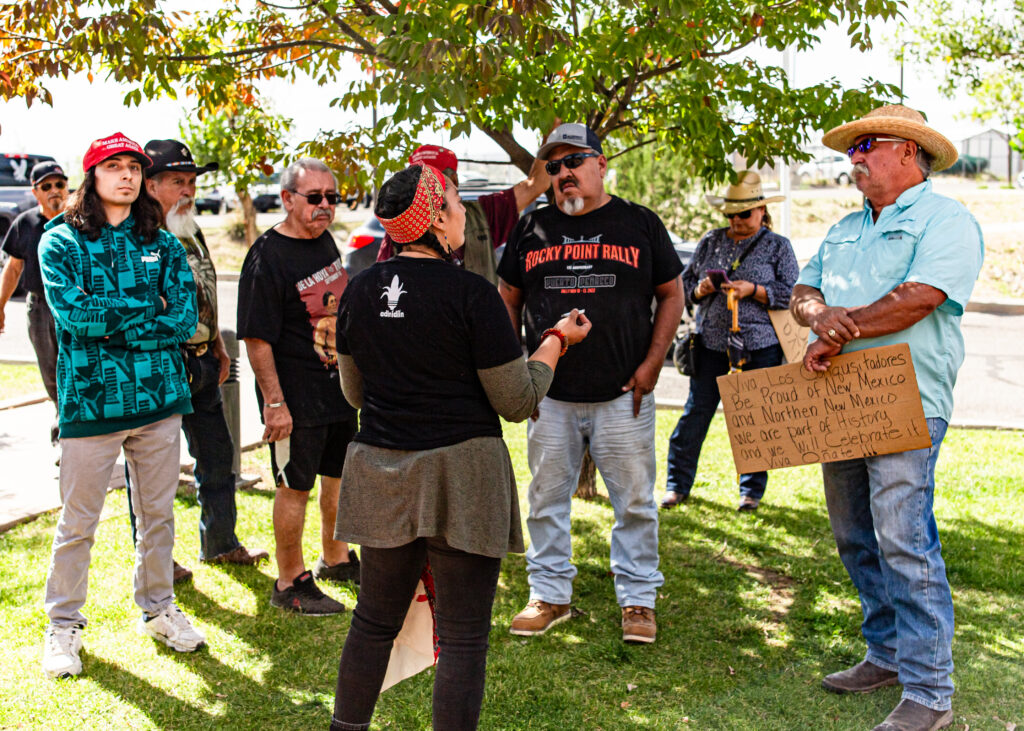One of the event organizers speaks with counter-protestors, including Ryan Martinez (left) who has now been charged with attempted murder in the shooting of an attendee during a peaceful protest in Española on Thursday, Sept. 28, 2023. (Photo by Anna Padilla for Source NM)
A man accused of attempted murder wants help from a former police officer to convince a jury he was acting in self-defense when he shot someone at a protest of a statue in northern New Mexico.
State prosecutors handling the case argue the testimony would confuse the jury, and an independent expert told Source New Mexico it’s uncommon for someone whose expertise is in police use of force to be testifying as an expert in a case about civilian use of force.
Ryan Martinez, 24, has been held in the Tierra Amarilla jail for nearly a year awaiting trial, which begins Oct. 7.
Last September, he was recorded on video carrying a concealed 9 mm handgun, repeatedly trying to rush into an area outside the county commission chambers in Española where around 50 people were peacefully celebrating county officials’ decision to postpone resurrecting a statue of genocidal Spanish conquistador Juan de Oñate.
Martinez shot Jacob Johns, a Hopi, Akimel O’odham activist from Washington, once in the chest. Martinez then allegedly turned the gun on Malaya Peixinho. The gun jammed, and he fled the scene.
The final round of litigation before the trial begins is scheduled for a Sept. 26 hearing before First Judicial District Court Judge Jason Lidyard.
Martinez’s lawyers are also asking the judge to prohibit Johns and Peixinho from testifying about their injuries from the shooting. Another issue Lidyard is expected to resolve is whether to allow former Albuquerque Police Department officer Damon Fay to testify.
Martinez’s attorneys in May notified the court they intend to call Fay as an expert witness.
They said he’s an expert in “use of force, including self-defense,” and they want him to testify about that along with “handling of firearms.”
State prosecutors in August asked the court to either limit Fay’s testimony or entirely exclude him from the trial, because the case doesn’t involve police use of force, the defendant is not a police officer, and the legal standards between how officers and non-officers use force are different.
First Judicial District Attorney Mary Carmack-Altwies wrote in a court briefing that Fay’s testimony would “undoubtedly confuse the jury by testifying to a police officer’s use of force when the Defendant is a private civilian.”
“A strict line falls between the use of force by law enforcement officers and private civilians: civilians are not authorized to use force,” Santa Fe’s top prosecutor wrote. “The standards of evaluation between the two are very separate and distinct.”
In response, Martinez’s attorneys Nicole Moss and Marshall Ray wrote Fay is certified to train both police and private citizens in the use of force in self-defense.
He’s qualified “by knowledge, skill, and training” to help the jury understand the “appropriate response to use of force by any human on another human,” they wrote.
GET THE MORNING HEADLINES DELIVERED TO YOUR INBOX
‘The rules are different’
Seth Stoughton is a former police officer turned law professor who regularly testifies as an expert witness in cases about police use of force. He is the faculty director at the Excellence in Policing & Public Safety Program at the University of South Carolina.
In an interview on Sept. 19, Stoughton said he refuses to take on civilian self-defense cases and security guard cases, “because the rules are different.”
“Of course the prosecutor is going to say, ‘It doesn’t matter what the police principles are here, or what a police officer would do, this is not a police use-of-force case,’ and I think that’s probably right,” he said.
Experts can testify about relevant aspects of civilian self-defense cases, he said. A psychologist, for example, could talk about why someone experienced a particular type of fear. Other experts could talk about the effects of fear on the human body, perception and cognitive processing, he said.
“There really isn’t — and there really should not be — a civilian use of force expert field,” Stoughton said.
The rules governing self-defense basically come down to how a reasonable person on the street would perceive and react to the situation, he said, and not what a trained police professional would do.
By contrast, police use of force is evaluated according to written guidance and training, Stoughton said.
The Rio Grande SUN reported that two days before the shooting when Martinez learned Rio Arriba County officials had postponed the statue ceremony, he wrote an email to County Manager Jeremy Maestas, “Has the ceremony really been cancelled (sic) tomorrow morning??My statue won’t return?”
The statue did not belong to Martinez. Stoughton said it’s worth noting there’s no self-defense claim for property. You can’t use deadly force to defend your own property, let alone a publicly owned monument that isn’t yours, he said.
Part of what frustrates Stoughton about violence around monuments is that while he recognizes and applauds the fundamental right to protest and counter-protest, he said physically fighting over what’s ultimately a political decision one disagrees with “is fundamentally anti-democratic and un-American.”
“You are showing, when you do that, a massive disregard and disrespect for democratic processes,” he said. “If you wanted that monument, vote for the people who support the monument. That’s how we handle issues of public dispute in a democracy.”
SUPPORT NEWS YOU TRUST.

